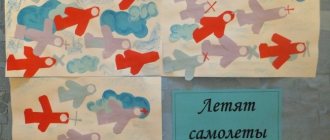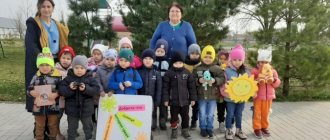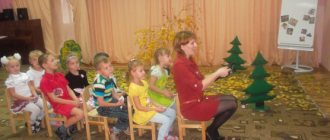Etiquette lesson in kindergarten in the 2nd junior group
Summary of an etiquette lesson for younger preschoolers “Who goes to visit in the morning”
Summary of organized educational activities in the second junior group (age 3-4 years) on the topic “Etiquette” Goal: Improve cultural and hygienic skills: the ability to wash hands before eating, use with a towel. Develop the simplest skills of behavior when visiting: saying hello when meeting, saying goodbye, wiping your feet when entering the house. Equipment: Heroes of the fairy tale “Kolobok” on magnets: grandmother, grandfather, Kolobok; Preliminary work: Reading the fairy tale “Kolobok” and playing it out in everyday activities;
Learning nursery rhymes, finger games, songs. Progress
The teacher invites the children to the theater and begins to tell a fairy tale and attach the characters to the board: Grandfather, Grandmother and Kolobok. Educator. Once upon a time there lived a grandfather and a woman. Grandfather once said: Bake a bun for me, grandma. The woman kneaded the dough with sour cream and baked a ruddy Kolobok and put it on the window to cool. Kolobok sat and sat on the window, became depressed, bored, jumped from the window and rolled along the path. Roll, roll, and the Hare meets him. He ran at such speed that he almost crashed into Kolobok. “What an ill-mannered Hare,” thought Kolobok. Educator. Guys, why did Kolobok think so? What did the hare do wrong? (I didn’t say hello to Kolobok when I met). Let's teach the Hare to say hello with a cheerful song.
M. Kartushina Hello, palms!
(stretch out their arms, turn their palms up and down)
Clap-clap-clap!
(3 clapping hands)
Hello, legs!
(stomp their feet)
Stomp, stomp, stomp!
Hello cheeks! (stroke cheeks with palms)
Plop-plop-plop!
(lightly pat the cheeks with their fingers 3 times)
Chubby cheeks!
Plop-plop-plop! Hello sponges! (shakes their head left and right)
Smack, smack, smack!
(smack lips 3 times)
Hello, teeth!
(shakes head left and right)
Click, click, click!
(click their teeth 3 times)
Hello, my little nose!
(stroke nose with palm)
Beep, beep, beep!
(press the nose 3 times with the index finger)
Hello, kids!
(wave hand above head)
Hello everyone!
Educator. (continues to talk) “Do you smell delicious?” - said the Hare, walking around Kolobok. - I'm very hungry. I found a little bag under the Christmas tree, but I don’t know what it was with. (Children determine what it is; if there is difficulty, the teacher prompts - it’s semolina). And Kolobok says: “Let’s go visit me, grandma will come up with something.” Kolobok and the Hare walk through the forest and admire nature. Visual gymnastics. Raise the carrot up and look at it. (They look up.)
Just look with your eyes: up and down, left and right.
(Eyes look up and down, left and right.)
Hey bunny, skillful!
Blinks his eyes. (They blink their eyes.)
He closes his eyes.
(Close their eyes.)
The bunnies took the carrots and danced merrily with them.
(We jump like bunnies). Educator. We've arrived. A hare ran into the house and everyone saw... dirty footprints. -What didn’t the Hare do when he entered the house? (did not wipe his feet). Educator. Why do you need to wipe your feet when entering the house? (children's answers). Educator. Before you start preparing semolina balls, what should you do? (wash your hands and put on an apron). Children's ability to wash their hands and use a towel is reinforced. We wash our hands with a saying. Oh, water, water, water we will always be clean. Splashes to the right, splashes to the left, our body became wet. I dry my hands very quickly with a fluffy towel. Before practical activities, do finger gymnastics. Once upon a time there lived a grandfather and a woman in a clearing by the river, (knock fist on fist)
And they loved koloboks with sour cream very, very much.
(clench and unclench your fists)
Although grandma has little strength, grandma kneaded the dough.
(shake hands)
Well, grandma’s granddaughter rolled the bun in her hands.
(to three palms)
It came out even, it came out smooth, not salty and not sweet.
(we stroke our hands one by one)
Very round, very tasty, it’s not even sad to eat it.
(clap our hands)
Together with Kolobok and grandma, make dough pies.
Each child has a piece of play dough on the table. Children form small pies. Children treat the Hare. In parting, the Hare thanks the children, Grandmother and Kolobok and promises to be well-mannered.
We recommend watching:
Musically-themed fairy tale for children of the middle group Didactic game for children 4-6 years old: Table setting Conversation with children of the older group on the topic “Culture of Behavior” Entertainment script about the rules of communication for children of the older group of kindergarten
Similar articles:
Scenario for a politeness holiday for preschoolers 5-6 years old in a preschool educational institution
Lesson “Polite words”. Senior group
Table behavior for preschool children
Game activities on the topic “Politeness” in the preparatory group of kindergarten
Games on the theme “Politeness” for preschool children 5-7 years old
Card index of conversations on the education of moral qualities of personality in preschoolers of the second junior group
Lyubov Sazonova
Card index of conversations on the education of moral qualities of personality in preschoolers of the second junior group
card 1 » Why do they say “hello!”
Goal: To form in children the basic rules of etiquette when meeting. Introduce greeting methods. To consolidate ideas about the importance and necessity of using “kind words” in colloquial speech, to arouse the desire to use them.
card 2 “My good deeds”
Goal: to deepen children’s understanding of kindness as a valuable, integral quality of a person. Improve communication skills (the ability to listen to a friend, sincerely express one’s opinion, show kindness to the opinions of other children, cultural communication skills with peers. Achieve friendly intonation expressiveness of speech. Cultivate in children friendly relationships, feelings of self-esteem and respect for others, the ability and desire to come to helping adults and peers.
card 3 “What is kindness”
Goal: To form children’s idea of kindness as an important human quality. Encourage the desire to do good deeds; strengthen children’s ideas about good deeds, understand that polite words help people communicate. Form moral ideas about kindness. Cultivate kind feelings towards people around you.
card 4 “Hurry to do good”
Goal: Continue familiarization with the polar concepts of “good” and “evil.” Form a conscious attitude towards social norms of behavior, consolidate the skills of friendly behavior in everyday life. Introduce ways to resolve conflict associated with feelings of anger, as well as ways to manage and regulate mood. Continue to cultivate friendly relationships between children.
card 5 “If you are kind...”
Goal: To develop in children the need for friendly communication with others, to consciously show empathy and perform kind deeds. To teach to understand the meaning of proverbs about goodness, the ability to associate the meaning of a proverb with a specific situation. Teach children to show kindness and responsiveness to everyone who needs it.
card 6 “Polite words”
Goal: To teach children the rules of etiquette, forms and techniques of communication when meeting with acquaintances and strangers, the rules of using greetings. Help overcome shyness and stiffness in children. Develop the ability to express your opinion in a cultural way, listen carefully to your interlocutors. Teach formulas for expressing polite requests and gratitude.
card 7 “Accidentally and on purpose”
Goal: to develop moral feelings - regret, sympathy; develop gaming communication skills without hurting your partner’s interests.
card 8 “Learning to forgive your friends”
Goal: to develop children’s ability not to be offended by each other; develop the ability to distinguish between an accidental mistake and an intentional one and react accordingly; lead children to understand the words “peace-loving”, “touchy”.
card 9 "Why do there be fights? "
Goal: to develop communication skills in children; develop an understanding of the meaning of norms and rules of behavior among peers; cultivate the habit of behaving with dignity in every situation.
card 10 "Dreamers and liars"
Goal: to develop the ability to distinguish between deception and fiction, fantasy; develop a desire for truthfulness and tact.
card 11 “Let’s make peace”
Goal: develop the ability to restrain negative impulses, avoid conflicts, find words to evaluate behavior. Teach children to be responsive and sensitive.
card 12 “A good friend is a friend in need”
Goal: to form the idea that a true friend knows how to empathize and help in difficult times; develop the ability to be merciful to each other.
card 13 “How to behave during a conversation”
Goal: to introduce children to the rules of behavior during a conversation.
(Speak in a polite tone. Use “magic” words. Look at the interlocutor’s face. Do not keep your hands in your pockets. You should not eat during a conversation. If two adults are talking, the child should not interfere in their conversation, much less demand that it stop) .
card 14 “Good - Evil”
Goal: To teach to give a moral assessment to the actions of heroes, to cultivate a desire to be kind and humane. To help you understand that a kind person can be called a person who always helps others and does not remain indifferent in situations that are difficult for other people.
Teach to distinguish good deeds, create a desire to do good deeds towards people around you.
card 15 “Truthfulness”
Goal: To form ideas about the moral concept of “truthfulness”, to teach how to give a moral assessment of the hero’s actions, to help understand that a lie does not decorate a person.
card 16 “What a friend should be”
Goal: To form ideas about positive character traits and moral actions, to deepen ideas about friendship. Cultivate respect, patience and friendliness towards your comrades, teach them to correct their mistakes, and ask for forgiveness in conflict situations. Teach children to be responsive and sensitive.
card 17 “Be neat and orderly”
Goal: To teach children to take care of their appearance. Help you understand that a well-mannered person always looks neat.
card 18 “Truth is not true”
Goal: To explain to children that they should not deceive others, that they should always tell the truth, that truthfulness and honesty always please adults, that these qualities are highly valued in a person, that they are praised for telling the truth. Help children understand that any lie is always revealed, and the person who lies feels guilty not only for his own offense, but also for the fact that he told a lie.
card 19 "Goodwill"
Goal: to continue to instill in children a negative attitude towards rudeness. Explain to children that the one who teases not only offends others, but also causes harm to himself (no one wants to be friends with such a person).
card 20 "Games without quarrels"
Goal: Explain to children that a quarrel interferes with play and friendship. Learn to resolve controversial issues, avoid quarrels, do not get angry at losing, and do not tease the loser.
card 21 “Politeness”
Goal: To teach children to use polite words, develop appropriate skills of cultural behavior, observe the rules of etiquette, using the example of images of literary heroes, stimulate positive forms of behavior and inhibit negative ones. That you need to communicate with others calmly, without shouting, that you should express your requests in a polite tone.
card 22 “Thrift”
Goal: To teach children to treat things with care and precision, otherwise they will quickly lose their appearance and become unusable. Teach to appreciate the work of those who made this thing, who bought it, earning money.
card 23 "Mutual assistance"
Goal: Explain to children that all people sometimes need support, but not everyone can ask for help; It is very important to notice the person who needs help and help him. That you need to help not only acquaintances, but also strangers.
card 24 “Striving to help”
Goal: To develop emotional responsiveness, the desire to help, showing empathy. Teach children to be responsive and sensitive.
Card 25 “Generosity and Greed”
Goal: To reveal the meaning of the concepts of “greed” and “generosity”. Develop the ability to evaluate your attitude towards positive and negative actions. Understand that being greedy is bad, but generous is good.
card 26 "Why you need to be able to give in"
Goal: to teach children to avoid quarrels, give in and negotiate with each other. Develop the ability to evaluate your attitude towards positive and negative actions.
card 27 "Steps of kindness"
Goal: based on the content of Russian folk tales, to form in children an idea of justice, courage, modesty and kindness, to cultivate a negative attitude towards negative qualities: lies, cunning, cowardice, cruelty. Learn to convey your attitude to the content of the fairy tale and the actions of the characters.
card 28 “It’s better to be kind”
Purpose: To give children an idea of an indifferent, indifferent person and his actions. Teach children to distinguish between the external manifestations of an emotional state (anger, indifference, joy). Learn to analyze actions, find the cause of the conflict, ways to resolve conflict situations and promote their assimilation in behavior. Generalize the idea of kindness and evoke the desire to do good deeds.




